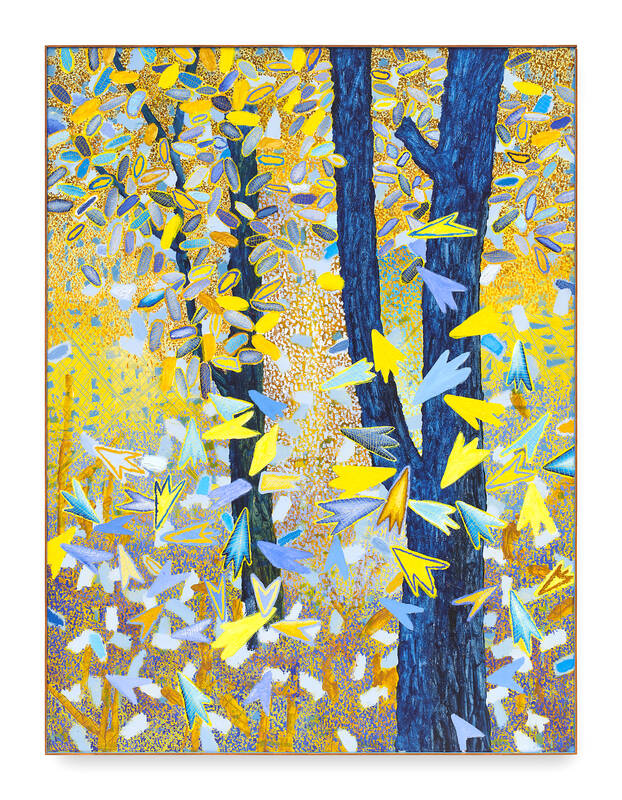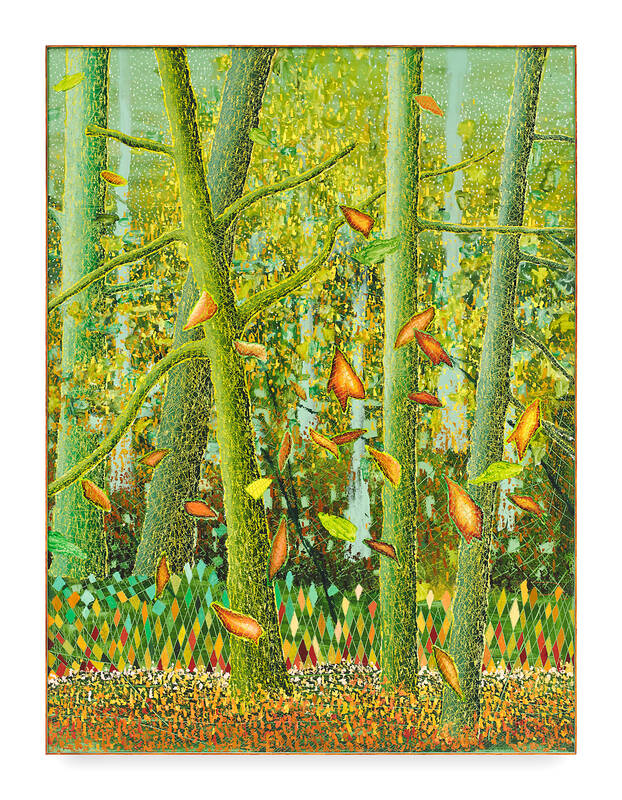Occupying the walls of an entire room of Asia Art Center’s (亞洲藝術中心) ground-floor gallery, Dawn Chorus — seven large canvas paintings depicting wild foliage, trees and forests — sing in unison of the inspirational beauty of the natural world.
“I painted them all at the same time,” LA-based artist Ross Caliendo tells the Taipei Times ahead of the exhibition opening, which was held on May 11 along with the opening of Exotica by Crystal Lupa (呂紹瑜), which is concurrently on show. “That way I could compare them and see how the different colors compliment and contrast with one another.”
The sense that the paintings are not just individual pieces but one conceptual work grows as you tour the room. One painting is deep green and autumnal, one fiery red and leafless, another purple, pink and evocative of spring. Yet all act as “a porthole to another world” as Caliendo puts it.

Photo: Thomas Bird, Taipei Times
According to the exhibition curators, these paintings were not just painted simultaneously but also “backwards,” a process that “involves the application of thick impasto over bright monochromatic underpainting in a contrasting color, that the artist then carves into with palette knifes, the back of brushes or other tools available in the studio to reveal the striking colors underneath.”
This unique approach, combined with a lifelong fascination with “color theory” as “reflected on the hue, value and chroma of his palette,” results in powerful interpretations of the flora that serves as the subject matter for the Dawn Chorus series.
PENNSYLVANIAN ORIGINS

Photo courtesy of Asia Art Center
While such artwork might reflect the lush valleys and blissful climate of California where Ross Caliendo lives and works, it feels a long way from the northern rustbelt city where he grew up.
“I’m actually from in Pittsburgh,” Caliendo, 36, says. “It’s an old industrial city. People say that it’s the sister city to Liverpool [in England].”
Despite being raised in an ostensibly blue-collar setting where “kids did sports,” Caliendo’s creative streak revealed itself early on.

Photo courtesy of Asia Art Center
“I was always doing creative things. I was the kid at school that could draw you the cartoon character that was popular on TV,” he says.
Curiously, Caliendo’s artistic abilities first provoked a desire to become a writer.
“I didn’t realize that the reason I wanted to be an author was because I was so interested in the covers of books. I was always making up these books so I could create the covers. Eventually, I figured out I wasn’t interested in writing but interested in drawing.”
Caliendo might have abandoned his literary aspirations early on, but a Tolkienesque other-worldliness combined with Henry David Thoreau’s naturalistic sensibilities invoke a poetic paradox in his work, one whereby the artwork appears to occupy the middle realm located somewhere between realism and fantasy.
“I don’t want to give the individual artworks names,” he says of the “untitled” paintings as we walk around the gallery space. “I let people decide what they are all about. I’m interested in energy and light, and I’ve just naturally come to this place where I’m using nature as an anchor.”
While Caliendo might not want to be too prescriptive about the meaning of his work, he does recall the time when he first saw the paintings that would go on to inform his art thereafter.
“When I was about 12 or 13 years old, my parents got me Saturday morning art classes at the Carnegie Museum of Art in Pittsburgh. A teacher took us around the museum. They had Egyptian art, medieval art, renaissance art right through to modern American art. And I remember there was work by [nineteenth century landscape painter] Winslow Homer and one by Willem de Kooning [a pioneering member of the twentieth century abstract impressionist movement]. These two types of paintings being right next to each other really blew me away. I didn’t understand how this naturalistic, beautiful painting could be placed next to this wild crazy splash of color. I found it inspiring because I just didn’t understand it. I realized then that being an artist was something that was possible. From that moment on, I was like, I’m just going to do that.”
Caliendo went on to undertake a Bachelor of Fine Arts (BFA) degree at Columbus College of Art and Design in Ohio, before relocating to Los Angeles, after briefly considering New York City as a base.
ART AS ENERGY
A decade in The Golden State had doubtlessly informed the artist’s work as light and nature are major elements in Caliendo’s paintings.
“The work is always transforming. I’m never really trying to say what the work is or isn’t about. Every piece is a journey and a reaction to the previous painting,” he explains of his process.
Living on the West Coast has also made him an established figure of the Pacific art scene, leading to opportunities across the pond, including Hong Kong and, of course, Taiwan.
“Melanie Ouyang Lum, who is one of the co-curators of this show, has been one of my major connections to the Asian art scene,” he explains. “I wouldn’t be here without her.”
But what does he think Taipei denizens will make of his multihued tree paintings on display in the concrete jungle of Neihu District (內湖)?
“I think nature is an amazing subject matter for artists ... because it is the closest thing to godliness,” he says.
“My hope is that the work sparks a sense of wonderment for being alive. I want the work to act as a catalyst, and a reminder that we are all together and present. I hope people connect with the work in that way.”

That US assistance was a model for Taiwan’s spectacular development success was early recognized by policymakers and analysts. In a report to the US Congress for the fiscal year 1962, former President John F. Kennedy noted Taiwan’s “rapid economic growth,” was “producing a substantial net gain in living.” Kennedy had a stake in Taiwan’s achievements and the US’ official development assistance (ODA) in general: In September 1961, his entreaty to make the 1960s a “decade of development,” and an accompanying proposal for dedicated legislation to this end, had been formalized by congressional passage of the Foreign Assistance Act. Two

Despite the intense sunshine, we were hardly breaking a sweat as we cruised along the flat, dedicated bike lane, well protected from the heat by a canopy of trees. The electric assist on the bikes likely made a difference, too. Far removed from the bustle and noise of the Taichung traffic, we admired the serene rural scenery, making our way over rivers, alongside rice paddies and through pear orchards. Our route for the day covered two bike paths that connect in Fengyuan District (豐原) and are best done together. The Hou-Feng Bike Path (后豐鐵馬道) runs southward from Houli District (后里) while the

March 31 to April 6 On May 13, 1950, National Taiwan University Hospital otolaryngologist Su You-peng (蘇友鵬) was summoned to the director’s office. He thought someone had complained about him practicing the violin at night, but when he entered the room, he knew something was terribly wrong. He saw several burly men who appeared to be government secret agents, and three other resident doctors: internist Hsu Chiang (許強), dermatologist Hu Pao-chen (胡寶珍) and ophthalmologist Hu Hsin-lin (胡鑫麟). They were handcuffed, herded onto two jeeps and taken to the Secrecy Bureau (保密局) for questioning. Su was still in his doctor’s robes at

Mirror mirror on the wall, what’s the fairest Disney live-action remake of them all? Wait, mirror. Hold on a second. Maybe choosing from the likes of Alice in Wonderland (2010), Mulan (2020) and The Lion King (2019) isn’t such a good idea. Mirror, on second thought, what’s on Netflix? Even the most devoted fans would have to acknowledge that these have not been the most illustrious illustrations of Disney magic. At their best (Pete’s Dragon? Cinderella?) they breathe life into old classics that could use a little updating. At their worst, well, blue Will Smith. Given the rapacious rate of remakes in modern